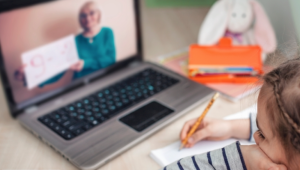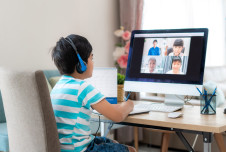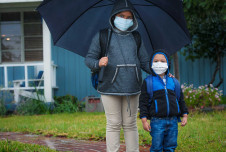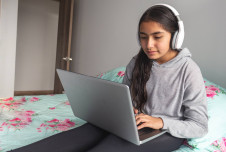On day four of the second round of distance learning this fall, I saw something on my first-grade daughter’s Zoom meeting that broke my heart—both as a parent and as a school psychologist who supports students with special needs.

In a sea of happy little faces in a Brady Bunch–style gallery, I saw a white board with a message on it, propped up on a desk. I strained my eyes to see it, and it read: “I can’t learn like this. I have special needs.” The kid was nowhere in sight. A parent had given up trying to get their child to engage on Zoom. On day four.
Distance learning is challenging for many learners, but can be even more challenging for students with learning, attention, or social-emotional needs.
As educators and parents, we are tasked with an unprecedented challenge: Figuring out how to reach and teach diverse learners online. It’s not easy. But it’s critical for so many of our students.
On my quest to crowdsource the best and most innovative strategies for supporting students with special needs during distance learning, I reached out to school psychologists and teacher leaders in my online communities. I posted the following question in my forums: “What is working well for teaching students with special needs online right now?”
Crickets.
I got no responses. Out of almost 20K school psychologists and thousands of teachers. Seriously?!? Was nothing working?
And then I realized, I was asking the wrong question.
Of course, not a lot is working well, because whole-class Zoom meetings are not exactly conducive for students who need personalized attention and step-by-step individual support. And we know that in real life and online, when kids can’t get that attention and support, they disengage. Like the little guy I saw in my daughter’s Zoom meeting, they log off (mentally or actually), and you can’t teach to a child who isn’t engaged at all.
So, I asked the question to my online forums in a different way: “How can educators increase engagement for kids with special needs online right now?” And that was the right question. The responses started rolling in, with innovative ways to engage kids online. And that got me thinking: Why is engagement the key to success during distance learning?
Because learning is not a place. It’s a relationship between teacher and student.
Nothing drives engagement more than a positive relationship. We can’t expect kids to learn without being connected. Connection fuels engagement—both in person and online. Any teacher will tell you that building a positive rapport with a kiddo is an essential ingredient for motivation and effort. And we can cultivate this positive relationship online. Here are three ways to boost engagement, connection, and support with learners with special needs.
1. Put the relationship before academic rigor
I get it. Teachers have a certain number of instructional minutes and curriculum to get through, and we don’t want kids to fall behind academically, especially children who already may have lagging academic skills. So, the natural temptation is to focus on academics and compliance of academic tasks, even when our children are under the stress of social isolation and the pandemic. But stressed-out brains don’t learn well.
We can learn from previous experiences with stressful events that displaced students. After Hurricane Katrina, students struggled when schools quickly focused too quickly on academic remediation. But when schools focused first on their social and emotional well-being, students were more likely to get caught up on the work.
The research on the benefits of social-emotional learning (SEL) as a lever for academic learning is more than compelling. Schools that focus on SEL can see an average of 11% improvement in academics. Indeed, for students with learning disabilities, one of the key factors for academic success is having support systems, like caring adults who help them navigate the challenges they face.
Since the beginning of the pandemic, I’ve been sharing my new mantra for educators and parents to illustrate this point that we need to tend to social-emotional needs first: Connection is Protection.
The good news is, educators can be a daily dose of buffering care for children with special needs, just by connecting on a personal level with their students. When students (and indeed adults) feel safe, seen, and supported, they experience more positive emotions, which boosts cognitive resources for learning.
And, yes, there are ways to engender genuine moments of connection, even on Zoom. Here are three resources that will get children ready for learning by building connection first:
- Edutopia’s How to “Maslow Before Bloom” (A toolkit for meeting students’ SEL needs online using classroom meetings).
- Jennifer Gonzales’ podcast: Creating Moments of Genuine Connection Online.
- Greater Good in Education is a go-to for quick, research-based SEL activities (many of which can be done over Zoom throughout the day). Get a curated list of activities that support well-being and connection during distance learning here and ideas for adapting practices for students with disabilities here.
While connection is the foundation for all learning, there are also universal design tactics for distance learning that will help all students with engagement. Angela Watson’s recent podcast, The Best Ideas from the Distance Learning Playbook, is a great place to start to get some innovative ideas for connection and engagement.
However, students with special needs will undoubtedly need more than connection and a cool Zoom engagement trick to succeed. Just like in the classroom, specialized support is often needed.
2. Get creative with accommodations and supports
Many students with special needs have challenges with independent learning. They often need specialized instruction and more scaffolded support, such as having tasks broken down for them into more manageable chunks, visual aids, and frequent check-ins to ensure they are on the right track.
In the classroom, teachers can give instant feedback and support. Students may also get pull-out services with specialists to teach them needed skills for focus, problem-solving, and emotional or behavioral self-regulation. Online, it’s really challenging to give that same “eyes on kid” and “real time” support.
One of the strategies that came up over and over in my online communities was using individual and small-group breakout rooms on Zoom. This virtual “push-in” support can give children with special needs extra instruction, encouragement, and support during tasks that they may not be able to do in the large group or independently.
This extra support can be done for longer blocks of time to do entire tasks together, or short check-ins before independent work to make sure the student knows what to do in a breakout room and has an opportunity to ask clarifying questions. Instructions on how work can be modified to the just-right level can also be communicated in this time. For instance, the student can be given reading assignments at their instructional level, alternative assignments that meet the same learning target, or shortened assignments that emphasize quality over quantity, such as doing every other math problem in the time period.
Another strategy for students who have disabilities that affect their attention or emotional self-regulation is to provide online spaces to bring stressed-out students’ brains back to the “calm zone” for learning. For example, one school psychologist in the Thriving School Psychologist community created a Bitmoji classroom full of online calming strategies for children who need a brain break, mindfulness activity, movement break, or self-regulation tool to use when they were overwhelmed. The teacher offered this to students who appeared to be struggling, and as a proactive strategy to prevent overwhelm in the first place.
3. Team collaboration
One of the challenges for students with special needs is that their support is more disjointed and remote. This is why building out a team of support is even more critical than ever before. Whether or not students with disabilities have a formal plan in place, such as a 504 accommodation plan or an Individual Education Plan (IEP) in special education, collaboration among other educators, support staff, and especially parents is key.
If you are an individual teacher who is struggling to support diverse learners in your classroom, consult with your school psychologist, special education team, and counseling support staff. These team members are on the forefront of emerging best practices and can consult with you to come up with innovative ways to ensure that kids feel connected, engaged, and supported.
Most importantly though, connect with the parents! Parents are doing the best they can with the tools and skills they have at home, under stressful circumstances. When educators partner with parents, especially now, when the parent is the primary source of support during the day, that’s where the real change can happen for our students. It’s my sincere hope that no parent ever feels like the parent I saw on Zoom who had given up.
This is the new normal for now. The landscape is constantly changing, so we must take measures to adapt, in the best way we can, with the tools we have available. While we can’t smooth out the ocean of challenges altogether to provide an ideal learning experience in a pandemic, we can figure out ways to ride out the waves together, so we are providing the best educational experience for our students as we possibly can. The only way we will get through this is together.








Comments